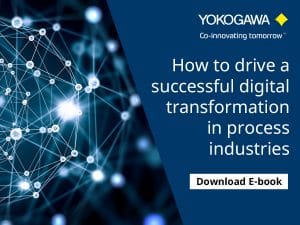For starters: just relax – there’s nothing for you to be afraid of. I’ll make three observations in that regard to begin with.
You won’t miss the perfect time for digitalisation. Because there simply isn’t any such thing.
Your company isn’t too small – nor too big – for digital transformation (DX) either.
I’m not commencing this blog post series to explain the evolution of industrialisation to you from Industry 1.0 to 4.0.
People have been talking about digital transformation, the so-called Industry 4.0, for ten years now. What began at that time as a future project for comprehensive digitalisation is transforming throughout society and establishing itself in industry. In particular, the last twelve months have given another enormous push in this direction. Worldwide, for instance, the pandemic has accelerated companies’ digital communication strategies by six years on average.
 The path from industrial automation to industrial autonomy
The path from industrial automation to industrial autonomy
Digital transformation offers opportunities in every corporate area to adapt and evolve in a world of rapidly changing marketplaces and technologies. Ongoing developments in digital technologies open up new possibilities in research and development and engineering, marketing, sales and services, right through to logistics and value chains. Maybe it will take a little longer in the process industry than in other sectors, but the benefits are infinitely greater.
Deriving optimal advantage of digital transformation includes the application of digital technologies to empower people, optimise processes and automate systems or organisations. As a result of digital transformation, the process industry is arriving at what we call “smart manufacturing”. Smart manufacturing in the process industry requires an integrated, contextual architecture. By this, I mean convergence, the merging of OT and IT. This requires openness and a willingness to accept the disruptive nature of previous architectures. For many end-users, an autonomous operation is an objective, i.e. making smart manufacturing a reality. At Yokogawa, we refer to the transition or path from industrial automation to industrial autonomy as IA2IA. All companies are at a certain stage of automated operation as a starting point. Take a look at the following animation and note what “stage” of the IA2IA journey you are on with your production.
The level of automation within the process industry is already very high, and the implementation of the automation pyramid has been established accordingly. Further steps towards smart manufacturing require the use of modern technologies and the acceptance of the fact that our beloved automation pyramid is too rigid for this.
There isn’t a formula for implementing DX!
Every company is unique in the way it puts its business strategy into action. Companies today also have differing levels of digital maturity. This relates to how large a company’s number of digitalised processes already is. Depending on the industry and the company’s size, digital maturity varies greatly. However, this doesn’t mean that the larger the company, the higher the level of digital maturity. Nor does the readiness for digital transformation depend on a company’s size and capital.
“Who always does what he is already able to do, always remains what he already is.”
Henry Ford
Much more decisive is people’s ability to deal with change in a company. Is there a willingness and the right attitude to follow a path of constant change and help shape it? The technologies required then only need to be used, adapted and applied. As a result, significant developments are actually no longer necessary. This means it isn’t a question of filtering out how many people want change but who wants to change. This factor highlights that a vision and plan are not the only things that need to be on hand. Rather, the realisation – the doing – is the priority. Success is doable and not just plannable. This circumstance entails risk as well. However, there is no such thing as 100% certainty in such a volatile and changing environment.
And exactly what Erica de Jong once said applies:
“The bad thing is, if you don’t risk anything, you risk even more”.
Join us here on this blog to find out more about digital transformation issues in the process industry. Read about what the difference is between automation and autonomy. And about the maturity model, NAMUR Open Architecture, flexible production and cases of Digital Twins applications.






